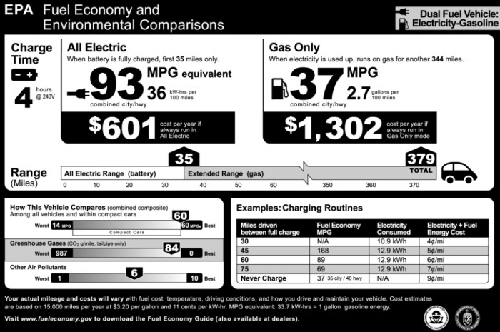Chevy Volt’s energy efficiency varies
The GM Chevrolet Volt is the first in a new breed of "dual-fuel vehicles" -- vehicles with energy efficiencies that will depend largely on how the cars are driven.
The Volt will refill its energy supply from two sources: from an electrical outlet with a plug to the battery pack and at a gas station with a nozzle to the gas tank.
Rather than one energy-equivalent reference number, the Environmental Protection Agency has tried to show a spectrum of energy efficiencies on the Volt's Monroney sticker to reflect the different combinations of these two fuel modes.
During electric-only operation, the Volt is rated at 93 MPGe, aka miles per gallon equivalent, for combined city and highway usage. This figure is based on a consumption rate of 36 kilowatt-hours of electrical energy for every 100 miles. The result is achieved only if the owner commutes just 35 miles per day and recharges the car's battery pack at night without the need for gasoline.
However, if the Volt's battery pack is not recharged and the vehicle is powered only by gasoline, the EPA estimates a combined city/highway rating at 37 mpg. EPA testing showed that the Chevy Volt would consume 2.7 gallons of gasoline to travel every 100 miles.
Extended-range travel of more than 300 miles would first start in electric-only mode and then switch to gasoline-assist after 35 miles. EPA testing has assigned a combined rating of 60 MPGe before both sources of energy would have to be replenished.
Annual fuel cost per year will also vary significantly, depending on how the plug-in hybrid Volt is driven. If driven in electric-only mode all year long for 15,000 miles, the Chevrolet Volt would consume about $601 over that time span. If driven in gasoline-only mode all year for the same distance, the cost would be $1,302. Cost estimates are based on an assumption that electricity will cost 11 cents per kilowatt-hour and gasoline will continue to cost $3.20 per gallon.
On the vehicle sticker, the EPA also tries to provide examples of mixed fuel use for different driving ranges within the extreme ends of this spectrum. A reference table on the lower right part of the Monroney sticker separates the amount of battery pack electric-energy capacity (up to 12.9 kilowatt-hours for the first 35 miles) from the amount of gasoline consumed (9-gallon gasoline tank) over different ranges between 30 miles and 300 miles. The reference table examples also compare relative costs of mixed electricity and gasoline usage over different range requirements.
Consumers should compare plug-in hybrids to gasoline-only vehicles by using the combined city/highway MPG or MPGe numbers from both technology platforms in order to consider overall energy efficiency. Then compare annual combined energy costs of a plug-in platform with the estimated annual fuel costs of a gasoline-only vehicle based on personal driving requirements.
After that, look at total purchase cost of the vehicle including available federal and state tax credits for new technology platforms. A dealership selling a plug-in hybrid car like the Volt or a battery-powered electric car like the Nissan LEAF may also require the consumer to buy a separate recharging portal and have it installed by a certified electrician. This requirement may be necessary to guarantee a long-term warranty on the battery pack.
The charging portal for the Nissan LEAF and its installation cost is estimated at about $5,000, but federal tax credits are available that drop the cost to about $2,500. The battery packs for both the Nissan LEAF and Chevrolet Volt have factory warranties of eight years or 100,000 miles.
There are also attractive lease options for the Nissan LEAF and GM Chevrolet Volt that may allow you to take advantage of diminishing costs on battery packs, electric drive trains and control systems in order to trade up for more range, power and energy efficiency over the next several years.
Happy shopping!
Stan Hanel has worked in the electronics industry for more than 30 years and is a long-time member of the Electric Auto Association and the Las Vegas Electric Vehicle Association. Hanel writes and edits for EAA's "Current Events" and LVEVA's "Watts Happening" newsletters. Contact him at stanhanel@aol.com














